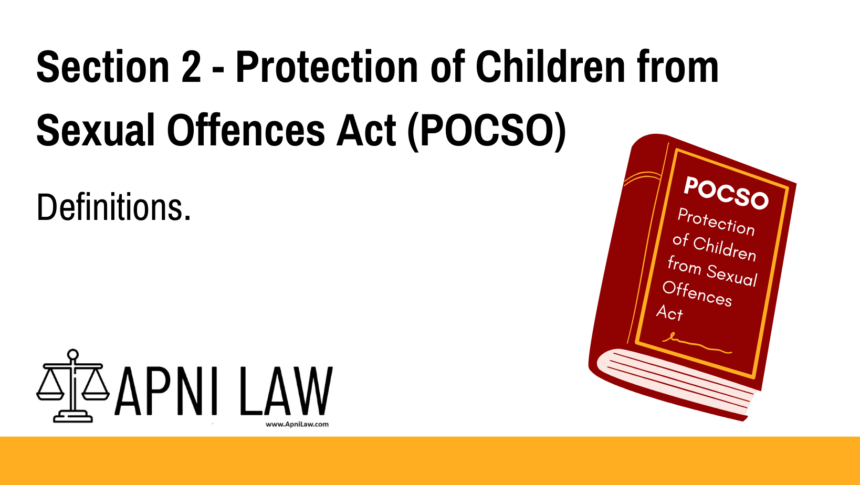Code: Section 2 POCSO
(1) In this Act, unless the context otherwise requires, —
(a) “aggravated penetrative sexual assault” has the same meaning as assigned to it in section 5;
(b) “aggravated sexual assault” has the same meaning as assigned to it in section 9;
(c) “armed forces or security forces” means armed forces of the Union or security forces or police forces, as specified in the Schedule;
(d) “child” means any person below the age of eighteen years;
[(da) “child pornography” means any visual depiction of sexually explicit conduct involving a child which include photograph, video, digital or computer generated image indistinguishable from an actual child and image created, adapted, or modified, but appear to depict a child;]
(e) “domestic relationship” shall have the same meaning as assigned to it in clause (f) of section 2 of the Protection of Women from Domestic Violence Act, 2005 (43 of 2005);
(f) “penetrative sexual assault” has the same meaning as assigned to it in section 3;
(g) “prescribed” means prescribed by rules made under this Act;
(h) “religious institution” shall have the same meaning as assigned to it in the Religious Institutions (Prevention of Misuse) Act, 1988 (41 of 1988).
(i) “sexual assault” has the same meaning as assigned to it in section 7;
(j) “sexual harassment” has the same meaning as assigned to it in section 11;
(k) “shared household” means a household where the person charged with the offence lives or has lived at any time in a domestic relationship with the child;
(l) “Special Court” means a court designated as such under section 28;
(m) “Special Public Prosecutor” means a Public Prosecutor appointed under section 32.
(2) The words and expressions used herein and not defined but defined in the Indian Penal Code (45 of 1860), the Code of Criminal Procedure, 1973 (2 of 1974), 2[the Juvenile Justice (Care and Protection of Children) Act, 2015 (2 of 2016)] and the Information Technology Act, 2000 (21 of 2000) shall have the meanings respectively assigned to them in the said Codes or the Acts.
Explanation of Section 2 POCSO
Section 2 of the POCSO Act lays the groundwork for interpreting the provisions of the Act by providing definitions for critical terms. These definitions are crucial for legal clarity and for ensuring uniform understanding and application of the law.
Here’s a breakdown of key definitions:
- “Child” means any person below 18 years of age.
- Offences like “penetrative sexual assault”, “aggravated sexual assault”, and “sexual harassment” are defined with reference to Sections 3, 5, 7, 9, and 11 of the Act.
- “Child pornography” includes all forms of visual depictions—whether real or simulated—that portray sexually explicit conduct involving a child.
- Other terms such as “Special Court”, “Special Public Prosecutor”, “domestic relationship”, and “shared household” tie in legal provisions from related legislations.
Sub-section (2) also clarifies that if a term is not defined within the POCSO Act, its meaning should be drawn from other major Indian laws like the Indian Penal Code, CrPC, the Juvenile Justice Act, or the IT Act.
Illustration
Example 1: Who is Considered a “Child”?
A 17-year-old victim in a sexual offence case qualifies as a “child” under Section 2(d) of POCSO, and all provisions of the Act will apply, regardless of their physical maturity or marital status.
Example 2: What is “Child Pornography”?
A person is found possessing digitally altered images of minors in explicit contexts. As per Section 2(da), this qualifies as “child pornography” even if the image is computer-generated or appears to depict a child.
Example 3: Application of “Shared Household”
If an accused was previously living with the child victim in a domestic setting, the place qualifies as a “shared household” under Section 2(k). This may become relevant in determining aggravated offences or patterns of abuse.
Common Questions and Answers on Section 2 POCSO
1. Why are definitions important in the POCSO Act?
Definitions ensure consistent interpretation across different courts and cases. They clarify the scope of the law and help avoid ambiguity during prosecution and defense.
2. What does “child pornography” include?
It covers any image—photo, video, or digital creation—that visually depicts a child engaged in sexually explicit conduct, whether real, computer-generated, or modified to appear so.
3. Is someone under 18 always protected under POCSO?
Yes. Anyone below 18 is considered a child, and the protections of the POCSO Act apply regardless of other factors such as consent or marital status.
4. Are definitions from other laws applicable here?
Yes. Section 2(2) ensures that if a term isn’t defined in the POCSO Act but exists in the IPC, CrPC, JJ Act, or IT Act, that meaning will apply.
5. What is a “Special Court”?
As per Section 2(l), a Special Court is a court designated under Section 28 of the POCSO Act to exclusively handle offences under the Act for faster and more sensitive trials.
Conclusion
Section 2 of the POCSO Act provides the backbone of the legislation by defining its core terms. These definitions are vital to effectively implement the Act and protect children from sexual offences. By referencing relevant sections and related laws, the provision ensures a holistic legal approach.
Need more clarity or legal support for child protection cases?
Explore expert insights and resources at ApniLaw today.








